Does working outside with the world as your office actually work?
Before my planned work-from-the-park day, I knew connectivity would be an issue, so I mapped out some relevant Xfinity wifi hotspots near parks ahead of time that might also have benches and power outlets.
With a folding lawn chair strapped to my back (with backpack straps) and a long extension cord under a cargo net on my bike rack, I biked out about 5 miles out to the Alviso Education Center, which has nice cement picnic tables, shade, and hotspots nearby.
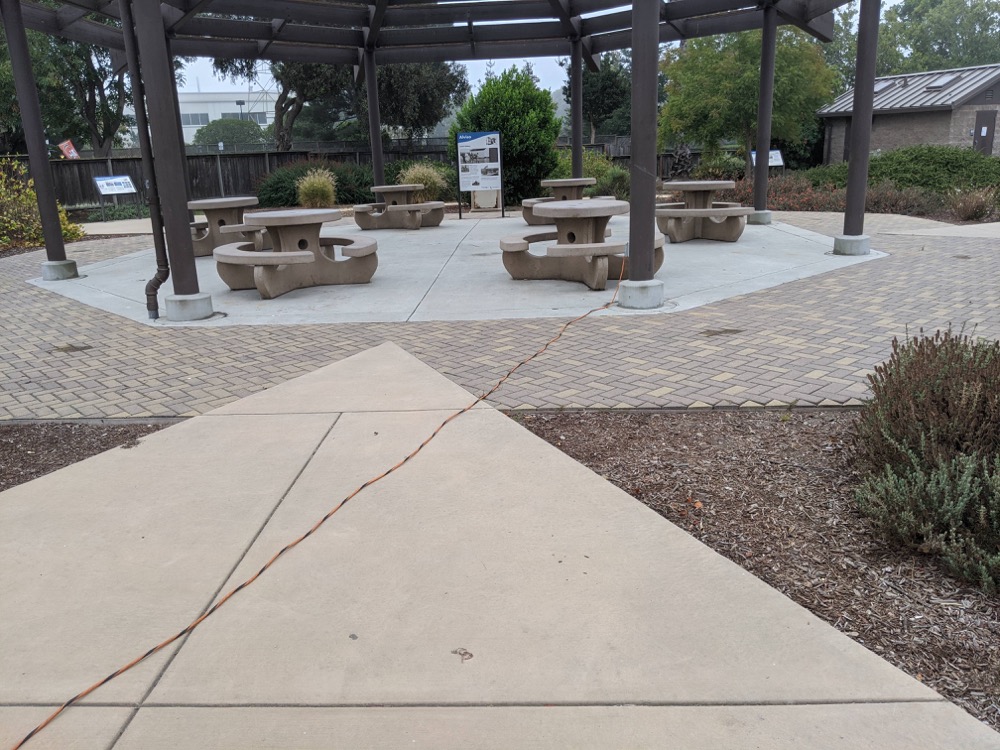
I set up my virtual outdoor office:
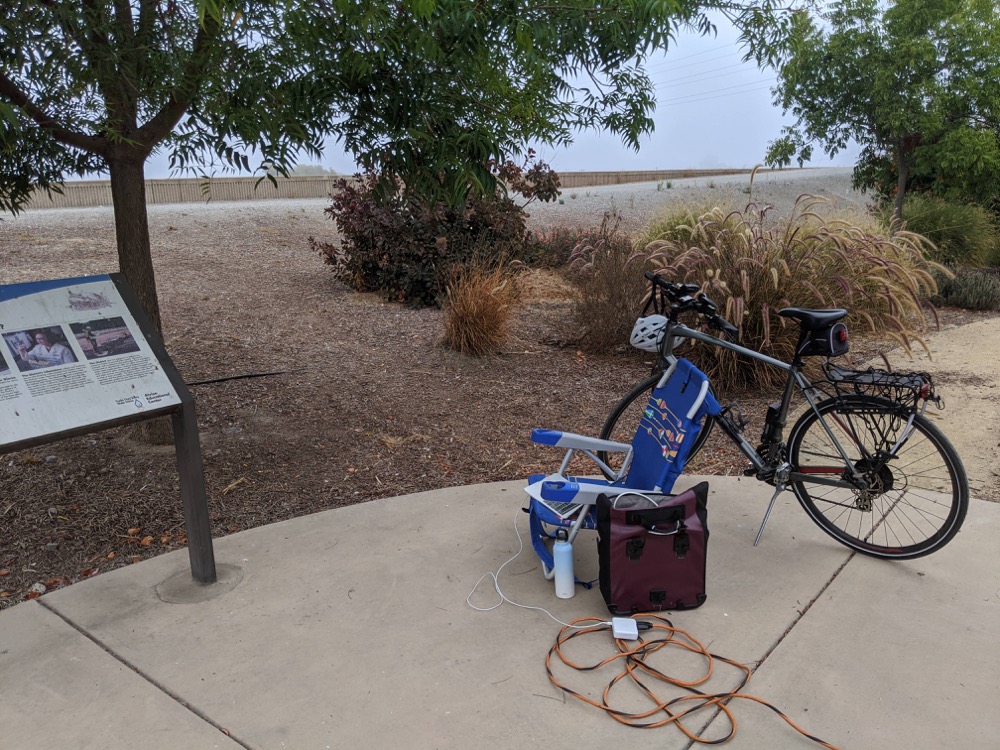
However, the power outlets were dead, and the Xfinity hotspots were too weak to provide a signal I could connect to. So I migrated to Baylands Park instead (just 1 mile away).
By the way, although hundreds of Xfinity wifi hotspots dot the map in Santa Clara County, I don’t think these hotspots actually work well unless you get 3 or 4 bars — and unfortunately, there are rarely any hotspots inside of parks. Parks, however, are one of the few places with areas where you can set up a virtual office. (I mean, I’m not going to prop up a lawn chair in the middle of a busy sidewalk outside of a business and try to work all day just to get a free wifi signal.)
Anyway, I gave up early on these Xfinity hotspots and decided to tether to a hotspot on my phone (on the Verizon network) instead. It worked surprisingly well, with about 15 Mbps at times. (This good connectivity is probably because most people are inside using wifi networks rather than outside using cellular networks, so the cellular networks are less congested. When the cellular networks are congested, forget about any hotspot speed above 3 Mbps.)
Sitting back in my lawn chair, I toiled away at some small work tasks (fixing doc bugs) for a few hours and was pleased with how well my outdoor office was working out. At times I was a bit cold, so I moved into the sun. Then I struggled to see my screen due to the sun’s glare, so I shifted to shade under a tree. That worked better, and because Baylands Park has a remote control airfield, I was right near old guys flying their remote control airplanes (and young guys flying drones), which was mildly entertaining. My time in the shade expired after about 45 minutes because it was too far from a power outlet, and my Macbook battery can barely hold a charge. So I switched back to the picnic tables under the sun.
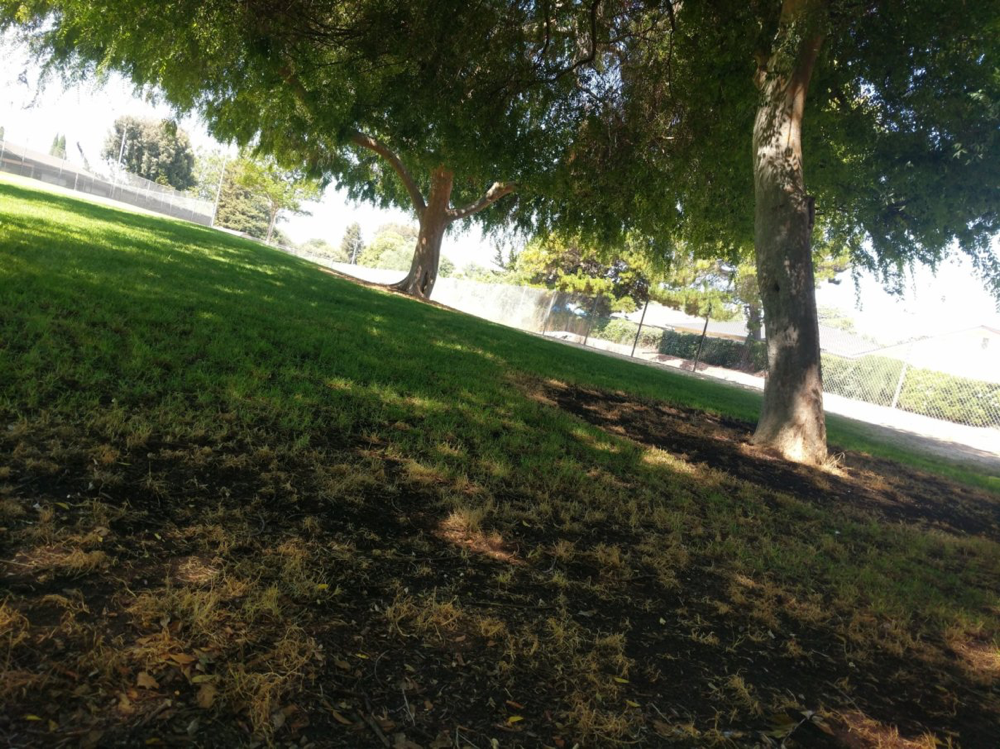
Although the weather was near-perfect (70’ish in northern California), after a while my eyes started to hurt from being in the sun. I put on sunglasses, but I still struggled to see my computer screen well (I even have a glare protector on the screen). I shifted from picnic tables to lawn chair a few times for variety and comfort. I packed some meager snacks (dried bananas, seaweed crackers, and an almond butter bar) that I nibbled on, and was surprisingly not starving for most of the day. I found it hard to work on a single small 13” laptop screen. I’m used to my 34” wide-screen Dell monitor with the 13” screen as a second monitor, dragging windows around.
Soon some amateur musicians arrived at the park, carried out some drum equipment, and started playing steel drums. At first, I thought it was cool — like being at a free outdoor concert. But they weren’t that good, and then the constant banging started to become grating. I tried drowning them out with a headset and music for the next hour, but steel drums are hard to block out. They continued for more than two hours.
Despite the nearby remote control flyers and steel drum musicians, I felt somewhat isolated at times. Nature is beautiful (Baylands has expansive protected wetlands areas), but I didn’t focus on my natural surroundings after a while. Soon I just became somewhat blind to the environment. I contemplated going out for lunch but wasn’t sure if I could ride my bike in a drive-through. Were restaurants even open for walk-in ordering? Taco Bell was nearby, but was I going to eat Taco Bell every day?
I ran into a technical glitch with some JS documentation widget I’d created at work and racked my brain trying to solve it. I wondered if I’d be more efficient at solving the problem if I were at home, or on a larger monitor, or with faster wifi.
My wife texted to say, half-joking, that she was feeling “separation anxiety.” We’d usually spent the day as working mates, in the same general room. I missed seeing the kids too, even if I only occasionally peered into their doors while they were in distance school. I liked listening to them descend into the kitchen boisterously during lunch (with four kids, it’s like a school cafeteria out there). Being outside and alone was kind of isolating. A lawnmower filled the background sound. Runners jogged past. Someone nearby smoked marijuana. There was moss growing on the picnic table.
As the hours clocked by, I joined a team meeting, and my colleagues immediately noticed my sunny park background. We talked about it for a while. I realized it seemed like I was enjoying the day outside while they were stuck indoors. The meeting went well, though, and I didn’t feel as isolated as before.
After the meeting, I returned to the JS widget problem again. I racked my brain trying to solve the technical glitch for another couple of hours in vain and then decided to call it a day. At 4:30 pm, I packed up my gear and biked home. I’d been out at the park for about 7 hours.
When I got home, my kids were excited to see me, greeting me at the door like I’d just returned from sea. My wife was a bit grouchy, though. In my absence, she’d retaken control of the chore chart. Apparently, she’d done the dishes four times that day, as well as cooked dinner. She was ready for me to take over, while I was kind of exhausted, strangely enough. I’d forgotten what a toll the commute takes. I’d only ridden my bike 5 miles to a nearby park and back, but the whole task of packing my bag and other gear, and setting off (and then park hopping), and returning reminded me of how much energy I usually expended commuting each day to work before Covid. Before Covid, my usual commute was 8.5 miles each way, and I often had just as much gear, if not more (though admittedly not a lawn chair strapped to my back).
My face felt windburned and a little sunburned, probably from over-exposure to UV rays. I was famished and made a huge mango shake and ate some cookies and toast, which I later regretted because I soon felt nauseated. Also, strangely I lost some sense of articulation with speech. My sentences seemed altered, like someone who had spent a few weeks alone in the wilderness. I felt more antisocial as well. I thought this odd because I’d only been at the park one day. To unwind, after dinner I spent a couple of hours curled up in bed, recovering while watching football and episodes of Evil. Then I worked more on solving the technical problem with the JS widget that I couldn’t fix at the park. (Technical problems will grate on me until I fix them, usually.)
Being inside all day must have made me soft, I thought. Prior to Covid, I would ride 8.5 miles to work in the morning, work all day, then (after work) play basketball for 1.5 hours, then bike 8.5 miles home, and get home at around 7 pm. I think if I did that now, I would faint. Maybe being outside more would toughen me up?
My family was eager to hear how my day went. I said it went okay. But I couldn’t get excited about returning to the park the next day. I don’t think I was all that efficient out there, trying to see different parts of a 13” screen between glare and different shady/sunny spots.
Also, I didn’t give enough consideration to the challenge of dealing with outdoor elements. What was my plan in winter, or on hotter summer days? I was out there during near perfect weather, but it would be a lot different if it were windy, or dark, or rainy. What was my plan then? The outdoor elements were tough to work in, even on a perfect weather day.
Also, there wasn’t much point in being outside, really. I wasn’t trying to avoid distraction, which is what my kids all assumed. I’m used to working in an office full of interruptions, loud conversations, people taking conference calls on speaker, and other noise. I usually just put on my headphones and blast some music, and then all the distractions fade away.
Instead, by going to this park, rather than avoid distraction, I wanted to recreate the separation between work and home. But even after I got home, I still did work. And I was also more tired than usual. Overall, I decided that working outdoors from a park or other outdoor area probably wouldn’t work. If you’ve ever brought your laptop to a beach or lugged it to your tent while camping and tried to do work, you know what I’m talking about. It’s hard to get set up and focus and be efficient. I realized that I’m actually much more efficient working from home, and not having that commute is ideal. Not having a commute saves a lot of energy. At the same time, the daily bike commute did a lot for me physically. I liked integrating exercise into my daily commute and schedule. I liked the structure of my day — leaving in the morning, returning in the evening. There are probably socio-biological rhythms built into that schedule. Ingress and egress are as old as the ocean.
One main problem with working outside is that it’s hard to see your monitor, and it’s not comfortable physically. The outdoor elements are more challenging to deal with, even in ideal conditions. I had a romantic idea of migrating from one spot to another (one shady tree for a while, and then biking to some other remote region when I grew bored, and setting up my chair in a new area), but I think I’m simply more efficient and productive at home, in an environment with controlled temperature and good lighting, with lots of screen real estate, a nearby espresso machine and snack food, some others around, fast wifi connectivity, a good webcam, and other amenities.
What about the work-life balance? Did working at the park at least address that? It did simulate some sense of being at the office, though, and reminded me of the commute. Was the price of that separation between home and office tied to a draining commute? In that space of driving or biking for 40 minutes or longer, you can mentally wind up in the morning and then decompress in the evening. The commute is exhausting, sure, but maybe that exhaustion has the benefit of giving you balance between work and home?
The experiment led me to reflect on larger work from home questions. A lot of us want to return to the office. Others are content to continue working from home. I do like going into the office, but mostly I like having more structure to my day. As a bicycle commuter, the commute forced me to bike, gave me more of a dedicated space to prepare and then detach.
The next day after my park experiment, I scrapped working outside and worked in my usual indoor home office space all day. It felt great, actually. I felt rejuvenated and no longer had those dilemmas about work-life balance. I solved the JS doc widget glitch with a better, more stable solution and was making lots of progress in other areas.
In researching what others have to say about WFH transitions, it seems the big question most are considering is what happens after Covid. Will we all go back to work as usual, or has office-based work fundamentally changed to a virtual model? Some company leaders suggest that, after Covid is over, workplaces will adopt more of a hybrid approach, with some set days when everyone is in the office, and other days at home. For example, three days in, two days out (or something).
Is that the ideal arrangement? I’m not sure. Clearly, working from home during the pandemic isn’t great. There’s a pretty strong trend where people are over-working and where work and home life are blurring in emotionally draining ways. Many of us feel like we’re always working. And the experience varies dramatically depending on who and how many people are at home. (It might be quieter without kids, but it also might be more isolating.)
At the same time, commuting into an office each day isn’t ideal either. The commute can be a real grind, especially if it eats 2-3 hours from your productive energy each day. (Don’t just consider the time spent en route; you also have to factor in the energy you expend too, and recovery time.) More and more teams I interface with are globally distributed, so even before Covid, I was rarely meeting with people in person at the office. I would basically go into the office and then meet with people virtually all day. It was kind of ridiculous to be there, living in Santa Clara and paying exorbitant rent prices while interfacing with remote teams. I longed to be co-located with an actual engineering team on site. I did have about 10 minutes of smalltalk conversation with my one tech-writing colleague, but we were focused on different projects and usually didn’t have more to say to each other beyond smalltalk.
The last few months prior to the Covid WFH time period, I was actually working closely with an engineering team. They were all down in Irvine (about 5 hours south of Santa Clara). They frequently dialed me in during standups, but not being co-located with them was somewhat problematic, and I felt excluded. They didn’t speak closely to the Polycom mics, and other meetings had similar audio issues. I frequently heard about information second-hand (e.g., such and such person left to another team, this re-org just happened and now the software development manager is this guy, the release was pushed out a couple of days, etc.). Usually we technical writers bounce from project to project, so these remote arrangements rarely last a long time. But I worked on this team for about 9 months. Being remote while everyone else was mostly in another location didn’t work out well.
And yet, when Covid happened and everyone started working from home, the entire dynamic flipped with this team. I could hear everyone at every meeting, and it was much easier to plug into different team dynamics. I didn’t hear about team lunches, off-sites, or other events I was missing (because there weren’t any). Covid was the great leveler between on-site and remote employees. But how will things go when Covid ends?
Spending some time in the office and some time at home (the hybrid model) seems like a good balance. However, I haven’t tried this model, so it’s hard to say whether it will lend itself to productive rhythms. For those days at home, will you slip out of work mode because you’re at home? Like a bed, you develop good sleep hygiene by only using your bed for sleep. If you use home as a place of work some days, but not others, will that throw off your momentum? Will you need to dedicate a permanent home office to maintain your momentum?
Also, going three days a week into the office removes the possibility of locating yourself in a remote, less expensive area. You’re still wed to an urban tech hub with expensive housing costs. And that dedicated office space is more problematic because, in those areas, more spacious houses are also more expensive.
Also, how would you sync your office schedule with other teams’ schedules? Would you stack all your meetings for the days you’re in the office? What if you’re supporting three different product teams, each with different in-office schedules that don’t necessarily harmonize with your own team’s in-office schedule? Many of the details about the hybrid model are still unclear, though it does seem promising.
At a fundamental level, the hybrid model tries to find “balance” between the two models (office and home). I can definitely get behind the idea of balance. We need balance in all aspects of our lives — balance between work and personal life, balance between family time and personal time, balance between physical exercise and rest, and so on. Even with documentation projects, it’s nice to have a balance between big projects and small projects, complex projects and simple projects.
I’m not sure why balance is so hard to achieve, or what the perfect formula is. But it’s fun to experiment. It’s only by trying out different models that you change perspectives and learn what works and doesn’t.
After my park experiment failed, I decided to adjust my model a bit. Rather than leaving all day for another environment, I decided to bookend my day with a simulated commute: a walk in the morning, followed by a bike ride at the end of the day. My wife already has me up and walking/hiking each morning at 6:30 am (usually at Rancho San Antonio).
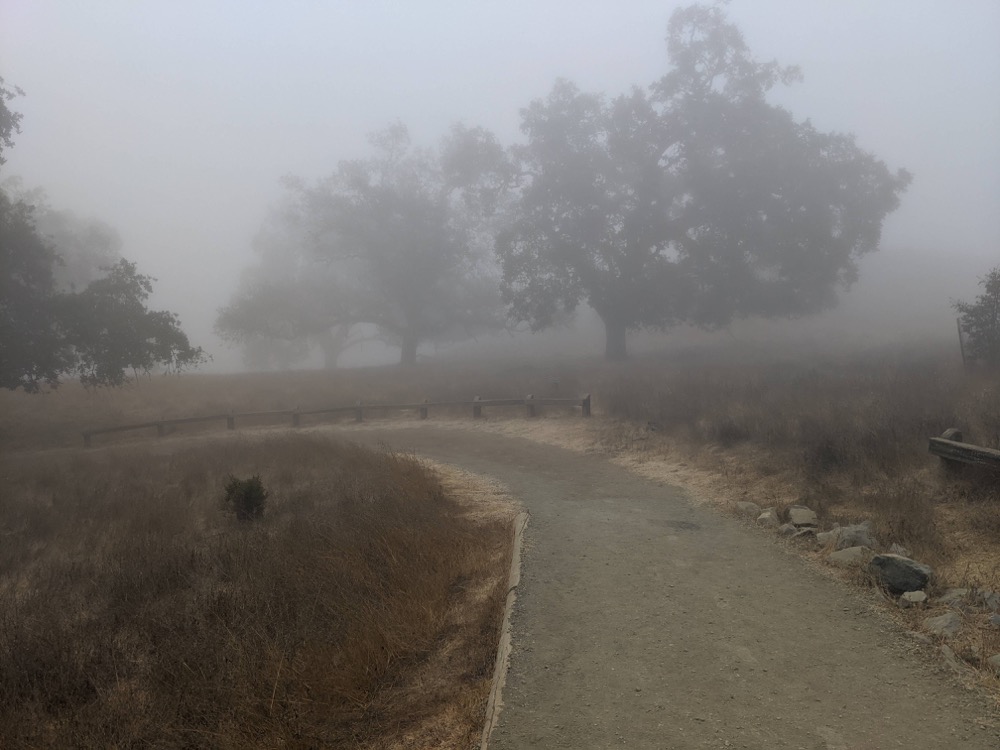
I love how the sun breaks through the trees at this spot. There are almost always deer by this tree:
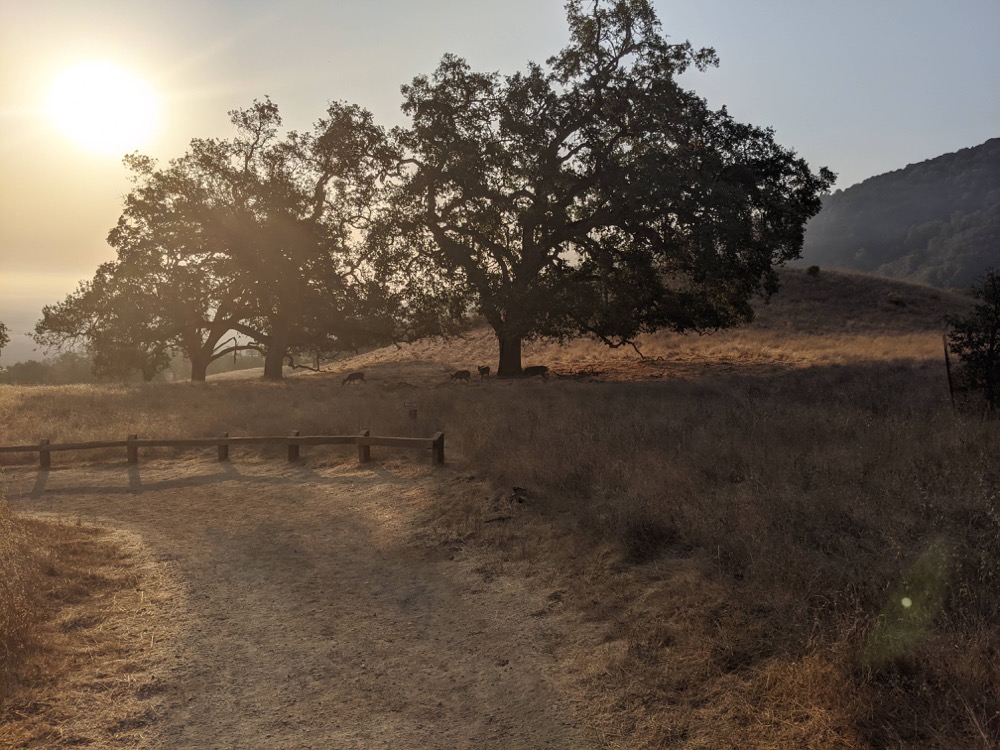
This is working well as a way to start the day. Then when 5 pm rolls around, I close up my computer and hop on my bike for the “commute home.” I bike about 10 miles (out to Baylands and back), and then return home at 6 pm.
Although I’m still trying this out (I only started yesterday), it seemed to work quite well. I had a mental sense of detaching from the workday and going home. I didn’t resume working in the evenings, and knowing that the day ended at 5 pm helped me focus more during the afternoon. I’m hoping to keep up this schedule.
What will happen when Covid is over, everyone is vaccinated, and we can all go back to work? Will WFH still be a strong trend, an accepted way of permanent working? Honestly, I kind of doubt it. I know I need the structure of leaving in the morning and returning in the evening. Whether the location needs to be a work office depends on who’s there and how productive the interactions are. But I also think the rhythms are too ingrained in our psyches to expect an overnight shift.
About Tom Johnson

I'm an API technical writer based in the Seattle area. On this blog, I write about topics related to technical writing and communication — such as software documentation, API documentation, AI, information architecture, content strategy, writing processes, plain language, tech comm careers, and more. Check out my API documentation course if you're looking for more info about documenting APIs. Or see my posts on AI and AI course section for more on the latest in AI and tech comm.
If you're a technical writer and want to keep on top of the latest trends in the tech comm, be sure to subscribe to email updates below. You can also learn more about me or contact me. Finally, note that the opinions I express on my blog are my own points of view, not that of my employer.

